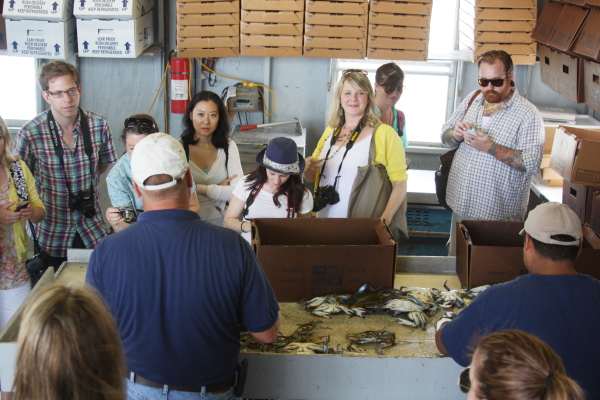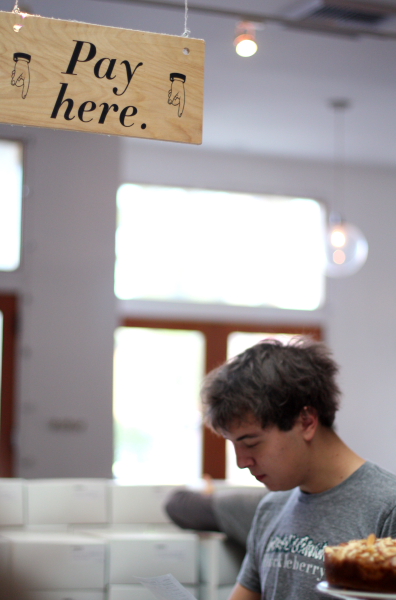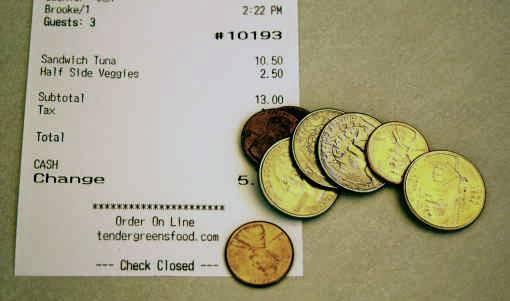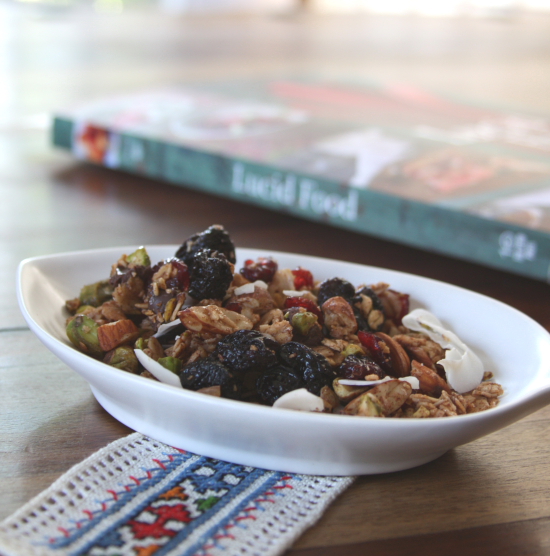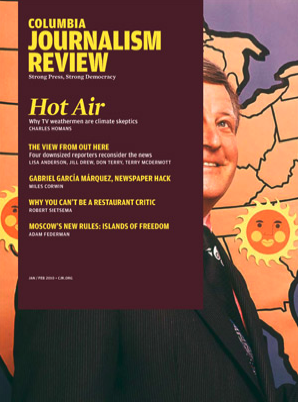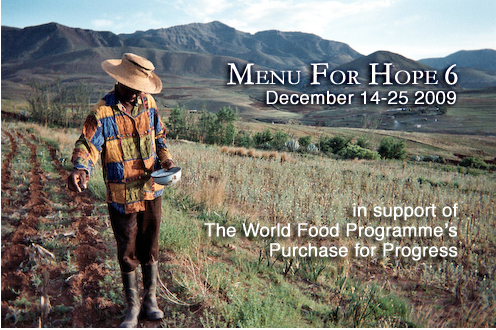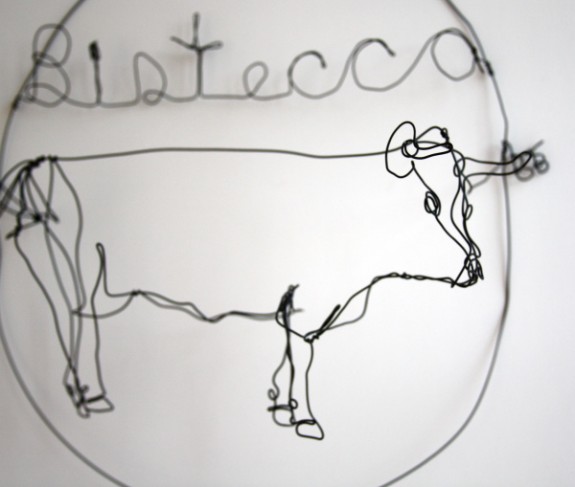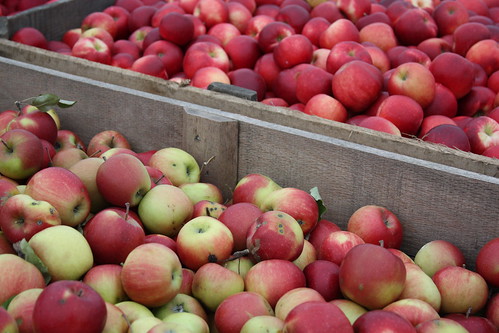
Thanks to America’s thriving love affair with food, many eaters today are keenly aware of what’s on their plate. Though yesterday’s diners were content with the simplicity of chicken with mixed vegetables, today’s food lovers desire something more specific—say, a dish that features local organic produce, butter from a family farm, imported sea salt and a flame-grilled free-range, organic Jidori chicken breast.
This relatively new found appreciation for food politics and understanding an ingredient’s history and origin may be due in part to the influence of the culinary media, innovative restaurants like Alice Waters’ Chez Panisse and best-selling books like Michael Pollan’s Omnivore’s Dilemma. Perhaps due in part to the booming wine industry, the US is populated with people that have made words like organic, varietal, terroir, and mouth-feel common in the national argot. In less than fifty years we’ve gone from a country of iceberg lettuce-eating jug wine-drinkers to a nation of arugula-nibbling wine aficionados. And despite the lagging economy, the market is full of flavor-seeking, politically minded, socially conscious consumers that are attentive to the ingredients they buy.

So it shouldn’t have come as a monumental surprise to a big city butcher when, in 2005, Carrie Oliver—a 40-something home cook and brand-marketing specialist—asked where the NY strip steak she bought came from. The butcher knew only the basics: the beef was hormone free, raised locally and considered USDA Prime meat. But, Oliver asked, after buying the same cut of meat week after week, why did the steaks taste so different if she was cooking them all the same way? The butcher shrugged. Could the steaks be from different kinds of cows? What were the cows fed? How was the cow raised? Why did identical cuts of meat sometimes have such a variety of flavor and texture?
Oliver was hungry for more information. Without a widely recognized book like Omnivore’s Dilemma to fuel her research in the practices of beef producers (the non-fiction tome would hit the best seller list one year later, in 2006), Oliver decided to start her own grass-roots study.
The quest to find the perfect steak

Armed with a handful of identical cuts of steaks purchased from local butchers and city grocers, Oliver and friends set out to taste through the grilled steaks to uncover what made each one different.

As the group tasted through the steaks they took notes. Some steaks tasted gamy—like blue cheese or liver–while others tasted of sawdust, or buttered popcorn. Textures varied as well. Some steaks were mushy while others were firm or chewy. Though all the meat was cooked to the same temperature, Oliver and her group realized that every steak offered different textures, mouth-feel, flavors and balance–factors that seemed undeniably similar to wine tasting.
The parallels with wine making peaked Oliver’s interest. The more Oliver researched, the more she began to understand that the way the cows were raised—on the land vs. in a pen–had a very direct correlation to how they tasted. Beef’s taste and mouth-feel is the result of terroir (where the cattle is raised), technique (how they are fed and treated), varietal (the animal’s breed), and—in a way—vintage (what sort of stresses that year’s environment presented). It became clear to Oliver that artisanal practices of ranchers, beef brokers and processors were undeniably similar in results to those of thoughtful wine makers.
 So why couldn’t great ranching practices be rewarded with market dollars, just as attentive wine making techniques have been? Beyond the political and ethical issues of grain fed cows (cows are ruminants and can not properly digest corn), Oliver hypothesized that thoughtful ranching and ethical husbandry were undeniably linked to taste.
So why couldn’t great ranching practices be rewarded with market dollars, just as attentive wine making techniques have been? Beyond the political and ethical issues of grain fed cows (cows are ruminants and can not properly digest corn), Oliver hypothesized that thoughtful ranching and ethical husbandry were undeniably linked to taste.
A brief glance at Harold McGee’s book On Food and Cooking, tells us she’s onto something.
“Despite the prestige of Prime beef, the current consensus among meat scientists is that fat marbling accounts for no more than a third of the variation of the overall tenderness, juiciness, and flavor of cooked beef. The other important factors include breed, exercise and feed, animal age, conditions during slaughter, extent of post slaughter aging, and storage conditions before sale. Most of these are impossible for the consumer to evaluate, though there is a movement toward store and producer “brands” that may provide greater information about and consistency of production.”–Harold McGee, On Food and Cooking
If marbling accounts for no more than one third of flavor, Oliver wondered why more people aren’t spending more time thinking about the other two thirds.
A revolutionary is born
Looking at the relatively recent success of artisan wine making in the United States, Oliver realized that the beef industry lacked a market that focused specifically on beef that was raised, processed, and butchered using only artisan techniques. Granted, books like Pollan’s Omnivore’s Dilemma has had an effect; Whole Foods market offers only hormone free beef and has grass fed and grain fed meat available at most stores. But national support for ethical practices in the 74 billion dollar beef industry has been minimal at best.
“Where there was once only Sanka or Juan Valdez for the American coffee drinker, ” the bright-eyed Oliver recounts at a recent beef tasting, “We now have a market saturated with coffee options—Ethiopian, Kenyan, Guatemalan. You name it.” But with beef? Oliver crosses her arms and gives her most enthusiastic grin. “Black Angus is today’s Juan Valdez.”
Undeterred by the powerful machine that is the beef industry, Oliver left behind her life in corporate America to start her own artisan beef business. With a mission statement, a website address, and an employee roster that included only herself, Oliver began the Oliver Ranch Company in February of 2006. Oliver’s goal was clear, she wanted to offer consumers beef that had a traceable history from farm to fork, had no added growth hormones or preventative antibiotics and consumed a100-percent vegetable based diet. What she created was an on-line, specialty food company that offers artisan steaks, sausage and beef jerky from a handful of handpicked beef ranchers, and is shipped directly to consumers.
Oliver’s biggest challenge is, like any new food-based businesses, is making that first contact with a group of consumers that do not yet realize the value of a specialty food. In today’s suffering economy it takes a very convincing argument to make someone want to buy meat on-line, rather than around the corner at the local butcher or grocery store.
There’s no denying the carbon footprint of shipping meat across the country. Oliver insists, however, that her business model for shipping artisan beef direct to consumers’ homes is a better choice for the consumer and the artisan beef producers in the long run. “If we properly reward those who are conscious stewards of the land and follow superior animal husbandry practices, we will be able to eat cleaner, more healthful, better tasting meat,” Oliver’s voice rises with a passionate staccato. “Most importantly, families can stay on their farms doing what they do best.”
Oliver admits her ace in the hole is flavor. “Once you taste the difference between one hundred percent grass fed or a grain finished meat,” Oliver explains to a recent tasting panel, “you’ll know exactly what it is you like.”
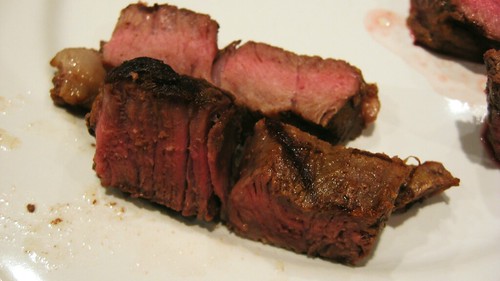
Oliver Ranch’s most popular product is the Taster Pack, a selection of four or eight different steaks (all the same cut, all from different ranchers and breeds), that allows people to blind taste test–in the style of a wine tasting–an array of steaks from different ranchers and different aging techniques. Since individual’s tastes differ, the winning steaks vary based on opinion.
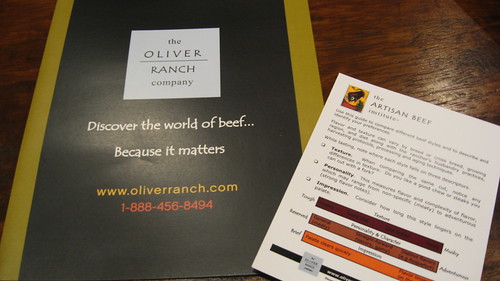
At a recent beef tasting in the Costa Mesa home of Todd and Diane of White on Rice, Carrie Oliver led a small panel of food writers (Leah from Spicy Salty Sweet, Matt from Matt Bites, myself) and invited chef, Steve Sampson, Chef of a soon-to-open Orange County restaurant Osteria Ortica, to a blind taste test of six steaks. Each steak was grilled for the same amount of time and was seasoned lightly with salt in order for tasters to understand the true flavors of the meat.
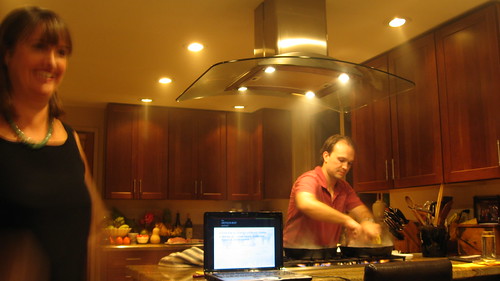
Tasters’ palates vary greatly, leading to a handful of favorites. Despite the Costa Mesa tasters’ socio-political aversion to corn fed beef, the overall winner for taste, however, was a corn, hay and fermented grass fed dry-aged Charolais-Cross (the breed of the cow) from the Elliott & Ferris Family Ranch in Front Range Region, CO. The Charolais-Cross’s meat had a tight grain, with a juicy, complex flavor that lingered, a good texture, and excellent bite. Other taste winners included a wet-aged Holstein-Friesian (a cross breed from a familiar milking cow) from Bob Beechinor of 3 Brand Cattle Company in Imperial Valley, California. That steak was complex and surprisingly gamy with its iron rich meat and almost liver-like flavor.
Groundswell vs. the elite revolutionary
Starting a demand for responsibly raised beef isn’t easy. With much of the beef industry’s concern in maximizing profits, cost per pound of meat, increasing marbling, grabbing USDA prime labeling and reducing cattle loss by increased use of antibiotics and hormones—Oliver’s fight has a David vs. Goliath ring to it.
Some could argue that Oliver Ranch’s choice to offer a variety of grass fed and grain fed beef isn’t the best socio-political choice. But with many consumers driven by flavor first, the promise of humanely treated animals is enough. In hopes of elevating the cause of seeking out the best ranching practices, however, Oliver created the Artisan Beef Institute, an organization that supports the discussion of ethical treatment of animals—from the farm, to the abattoir, and the butcher’s board—and educates consumers about good ranching practices, breed variations, the affects of feed on different breeds.
“There’s a lot of misinformation in the category of beef. You want to do the right thing,” Oliver explains, “but how do you do it?”
With politically-minded food lovers like Michael Pollan, Alice Waters, Barbara Kingsolver, and Carrie Oliver working hard to create a common language and understanding of the origins of the foods we eat, we may very well be on our way to having better ingredients on our plate.
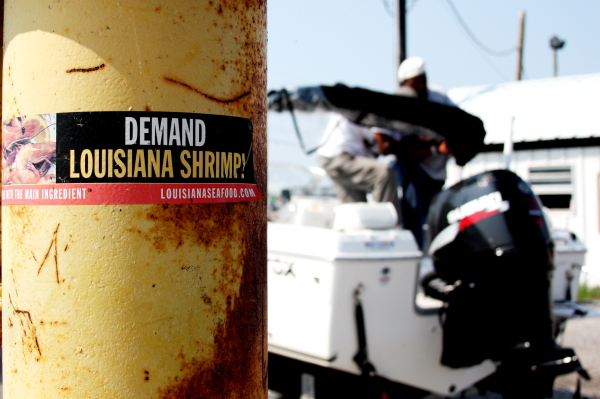 “When you think of all the news you’ve seen about Louisiana, what images flash through your mind?” asked Mike Voisin, a seventh-generation Louisiana oysterman. Voisin, the CEO of Motivatit Oysters, paced around the air-conditioned conference room as he spoke to his visiting guests.
“When you think of all the news you’ve seen about Louisiana, what images flash through your mind?” asked Mike Voisin, a seventh-generation Louisiana oysterman. Voisin, the CEO of Motivatit Oysters, paced around the air-conditioned conference room as he spoke to his visiting guests.